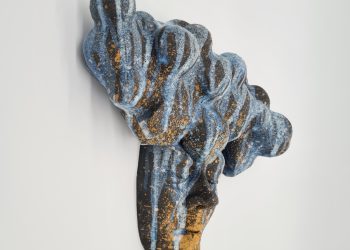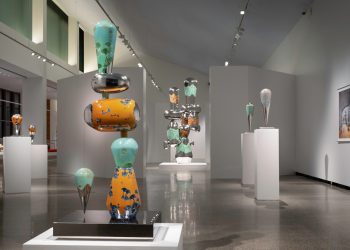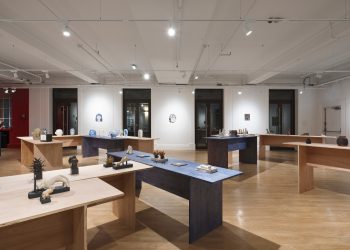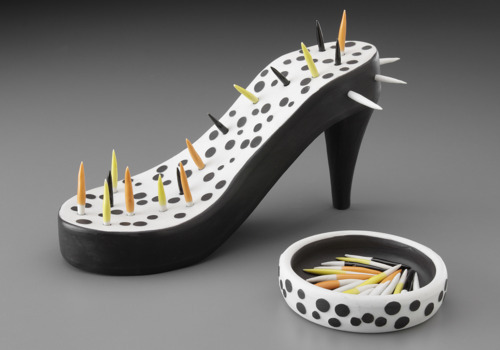
The versatility of your work is very inspiring and makes the viewer ask himself whether he should play with your works or just to admire their universe. When did you begin to create such intricate pieces?
Thank you for your kind words. I began to create interactive sculptural pieces about 7-8 years ago after I had been working in clay for about three years or so. From the outset, drawing the audience into touch and explore has always been a goal. But also, I have intended for each work to have its strong essence that invites contemplation/reflection.
Modularity and interactivity are two main characteristics of your work. How much time does it take to complete a new work? Do you make many sketches?
My interactive sculptures generally take many weeks. The germination of an idea and realization of each work can also be a lengthy process, particularly when there are complicated construction or even “engineering” issues involved. I can sometimes spend a couple of months in the “head-scratching” stage and work on other projects while I sort out the steps and best approaches. I do keep a notebook with sketches and notes, but I do not personally find it easy to translate some of these projects onto the page. With a fairly good aptitude for spatial relations, I hold much of the planning in my head initially. Because I build primarily in porcelain, extremely slow drying is key — I cannot emphasize this enough. And, of course, this also adds to an already long creation process.
Some of your works consist of multi-component pieces that, put together, metamorphose each time in different compositions. Do your Interactive Sculptures illustrate the ludic dimension of art? How important is this element for you?
My answer depends on the tenor of the word “ludic”. Although the mere invitation to rearrange components may seem a playful act and some of my sculptures may even possess qualities of games, the interaction by the audience has never seemed aimless to me. To the contrary, I witness people being extremely thoughtful about what they are creating as they rearrange components. The idea with these works is that there are nearly innumerable permutations that the viewer can create, all of which will reveal different aspects of the sculpture’s essence for contemplation.
This interactive component of my work is quite important to me. I feel art should move the viewer away from a type of isolation that has been brought on by the abundance of “personal” technology that has come about during our time. In the evolution of my work, the questions that have guided me (at times, subconsciously) have been “what inspires connectedness?” and “what can most powerfully engage our attention?”. Thus much of my work is intended to draw the audience out, either in the questions it poses or the interaction it invites.
When working on a new piece, do you seek for inspiration within yourself, or do you get influenced by what should be the purpose of your work?
Both my pieces arise from some force within me, usually a subconscious one. As the idea unfolds and develops, its purpose is gradually clarified.
You have received international recognition for your ceramic works — multiple awards and many publications, but this isn’t the only recognition you are receiving. You are also a professional musician (winner of the Noah Greenberg Award), and you teach flute and chamber music at Wellesley College. How do you manage to find the much needed time for both activities?
That is an excellent question! There are certainly not enough hours in a day or days in a week for all the work and activities I would like to do. My musical performing and teaching have a seasonal rhythm, so my ceramic work tends to intensify during the ebbing of my responsibilities as a musician and educator. That being said, my ceramic work is never completely on hold — even during those days and times when I am not actively building, I am still working through the steps to realize my more complicated projects.
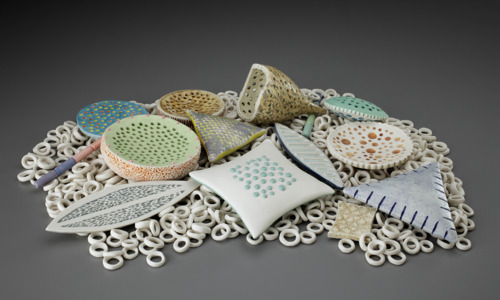
Diatoms, 2011, 16”w x 11”d x 3.5”h, handbuilt with wheelthrown components; porcelain and porcelain paperclay; oxidation fired to cone 10
What advice would you give to an artist at the beginning of his career? Is ceramics the right medium for expressing ideas? Or is it music?
In finding and choosing an artistic pursuit, I encourage people to notice to what they are drawn and then to explore it! Listen to your heart and intuition: if you listen carefully and openly, your innate knowledge of what resonates in the most stimulating way in your soul will become apparent. Throughout your life, continue to remain flexible and open, because we are all works in progress, and one’s focus will need to adapt to this ongoing personal evolution.
By Vasi Hîrdo
Published in Ceramics Now Magazine Issue 2
View Suzanne Stumpf’s profile on Ceramics Now.
Visit Suzanne Stumpf’s website.















